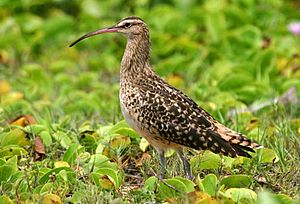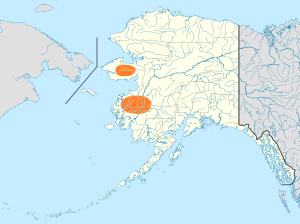Bristle-thighed curlew facts for kids
Quick facts for kids Bristle-thighed curlew |
|
|---|---|
 |
|
| Conservation status | |
| Scientific classification | |
| Genus: |
Numenius
|
| Species: |
tahitiensis
|
 |
|
| Breeding range | |
| Synonyms | |
|
Numenius femoralis |
|
The bristle-thighed curlew (Numenius tahitiensis) is a special type of shorebird. It is about the size of a chicken. These birds breed in Alaska and then fly south for the winter. They spend their winters on warm, tropical islands in the Pacific Ocean.
Contents
About the Bristle-thighed Curlew
What Does It Look Like?
This bird has a long, curved beak that points downwards. It also has unique bristly feathers near its legs. Bristle-thighed curlews are usually about 40–44 centimeters (16-17 inches) long. Their wings can spread out to about 84 centimeters (33 inches). Female birds are usually a bit bigger than males.
Their feathers are spotted brown on their upper body. They have a lighter belly and a tail that is rusty or buffy in color. You can tell them apart from similar birds, like the whimbrel, by the bigger spots on their back. They also have a plain light belly and a pale, orange-buff colored rump.
Where Do They Live?
The total number of bristle-thighed curlews is around 7,000 birds. They are rarely seen near big cities or towns. Only a few sightings have happened in places like Canada, California, and Oregon.
These birds build their nests in Alaska. They prefer low, flat areas of tundra close to the ocean. Their nests are simple dips in the ground. They line these nests with soft tundra moss. Each nest usually has four greenish eggs with brown spots. The parents raise one group of chicks each year. Both parents take turns sitting on the eggs for about 25 days. They also protect the chicks after they hatch.
Their winter homes are warm islands across Oceania. These include places like Micronesia, Fiji, Tuvalu, Tonga, the Hawaiian Islands, Samoa, French Polynesia, and Tongareva.
What Do They Eat?
Bristle-thighed curlews eat many different things. They enjoy plants like flowers and berries. They also hunt for insects and small sea creatures. What's really cool is that they are the only shorebirds known to use tools! They use rocks to break open other bird's eggs to eat what's inside.
Amazing Migrations
When their chicks are about five weeks old, the adult birds leave them. They start their long migration south. The young birds stay behind and keep eating until they are strong enough to fly.
Their first big flight is a non-stop journey of about 4,000 kilometers (2,500 miles). They fly all the way from Alaska to Laysan Island. These amazing birds can fly non-stop for more than 6,000 kilometers (3,700 miles)!
Unique Facts
Bristle-thighed curlews are special for a few reasons. They are the only shorebirds that cannot fly during their molt. This is when they lose their old feathers and grow new ones. Also, when they start their migration, they fly in small groups. They don't follow a set pattern of flying only during the day or night.
Protecting These Birds
There is some worry about these birds in their winter homes. People are building more in these areas. Also, new predator animals have been brought to the islands. These new predators can be a danger to the curlews.
Images for kids
See also
 In Spanish: Zarapito del Pacífico para niños
In Spanish: Zarapito del Pacífico para niños




